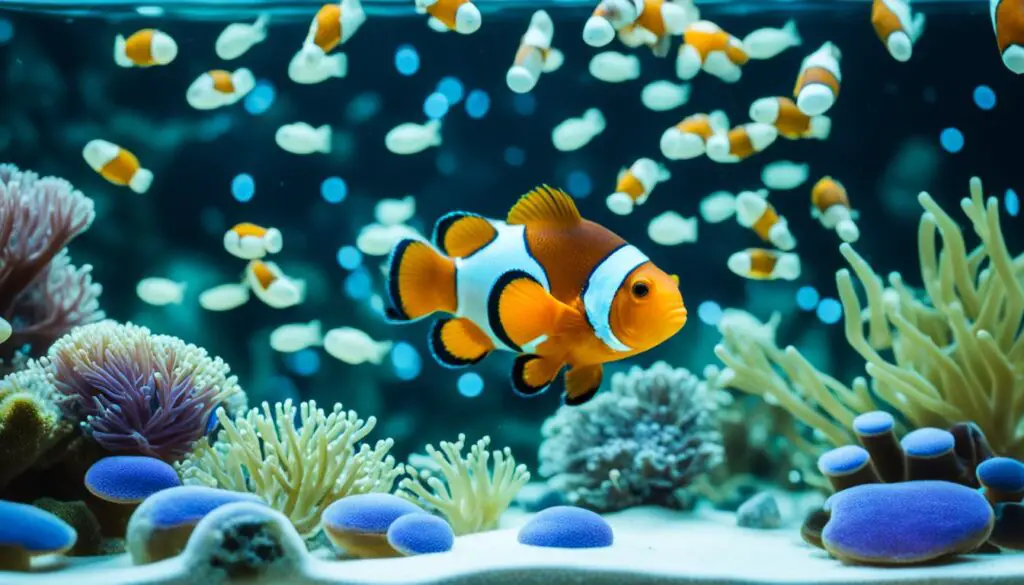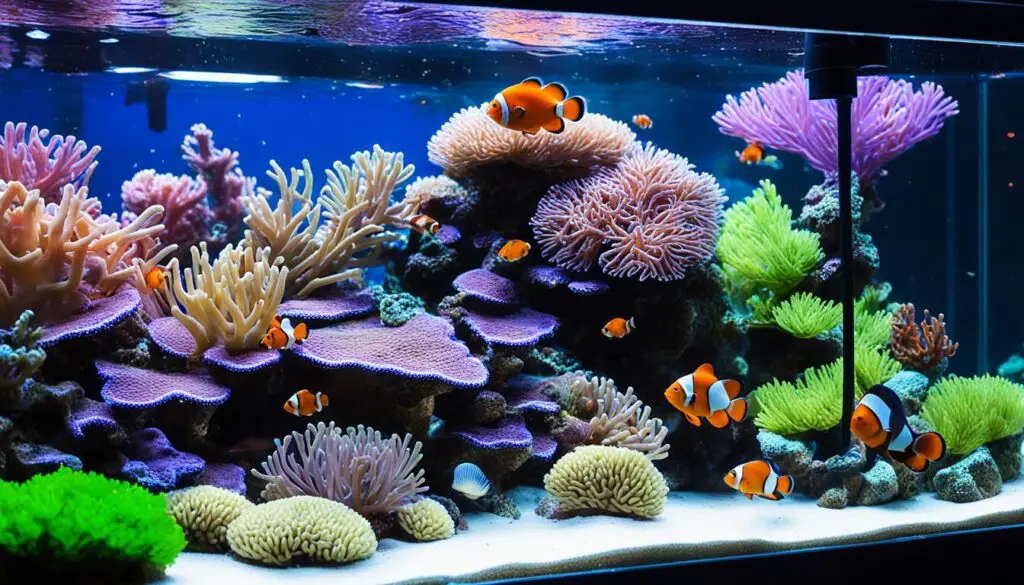Treating Clownfish Tank Diseases: A Comprehensive Guide

Being a fishkeeper, I know how vital it is to keep my clownfish healthy. Sadly, diseases can sneak into any tank, hurting our little underwater friends. This guide covers the many diseases that affect clownfish and how to treat them.
There are quite a few illnesses that can afflict clownfish. These range from common ones like ich and velvet to rarer issues like lymphocystis and intestinal worms. Knowing what to look for and how to fight these diseases is key to keeping our fish strong.
I’ve done a lot of digging into this subject. I used trusted sources like the Pictorial Guide to Marine Fish Diseases and The Beginner Guide to Saltwater Fish Disease. Plus, I gathered advice from other fishkeepers to give you the best info out there.
Key Takeaways:
- Clownfish tank diseases can pose a threat to the health of our fish.
- Understanding the symptoms, causes, and treatment options for various diseases is crucial.
- Reputable resources and fellow fishkeepers’ experiences can provide valuable insights.
- Proper tank maintenance and quarantine practices play a vital role in disease prevention.
- A wide range of treatment options is available, tailored to specific clownfish diseases.
Common Clownfish Diseases and Treatment Options
Clownfish are well-loved, but they can get sick. We’ll look at the most common illnesses and how to treat them. It’s crucial to know these diseases and what to do if your fish gets sick.
Ich (White Spot Disease)
Ich is White Spot Disease, a top issue for clownfish. It’s from a parasite called Ichthyophthirius multifiliis. Fish get small white spots and might start rubbing on things.
Treating ich has a few steps. You can use special over-the-counter meds or increase the tank’s heat to 82°F. Always follow medication directions and watch your fish closely.
Velvet (Oodinium)
Velvet, caused by Oodinium ocellatum, is also common. Fish look like they’ve been dusted with gold or yellow. They may eat less, make more mucus, and breathe quickly.
Copper meds are often used for velvet. Keep sick fish in a different tank to stop the disease from spreading.
Flukes (Monogeneans)
Flukes are flatworms that bother clownfish gills. They cause itching, trouble breathing, and odd behaviors.
Using meds for flatworms is key to fluke treatment. Isolating sick fish can help stop the parasite from spreading.
Bacterial Infections
Bacterial infections can lead to fin rot, ulcers, and strange swimming. These may stem from dirty water, injuries, or stress.
Treating bacterial infections varies. Fish antibiotics like tetracycline or erythromycin work well. Fixing water issues and reducing stress is crucial for their recovery.

Knowing about clownfish diseases is vital for any owner. quick care improves survival odds. Next, we’ll cover rarer diseases and how to treat them.
Unique Clownfish Diseases and Treatment Approaches
Clownfish can get both common and rare diseases. Today, we’ll look at three unique illnesses they can face. These are Brooklynella, lymphocystis, and intestinal worms.
Brooklynella
Brooklynella, also known as Brook, is a serious illness for clownfish. A tiny parasite causes it, leading to too much mucus, trouble breathing, and a white film. It can kill the fish if not treated.
Treating Brook involves using special medications. Methods include freshwater dips and using copper or anti-protozoal drugs. Always follow the medication instructions and get advice from experts.
Lymphocystis
Lymphocystis causes growths on the skin and fins. These looks like cauliflower and don’t usually hurt the fish much. But, it’s very contagious.
To prevent lymphocystis, keep the water clean and feed your fish well. A stress-free space and quarantine can stop it from spreading.
Intestinal Worms
Clownfish can also get sick from intestinal worms. They cause weight loss, lack of appetite, and slow movement. Worms may come from live food or a wild fish.
Treating worms requires specialized medications. These are given by mouth or mixed in the food. Always use these as directed by the product or a vet.
Diagnosing clownfish diseases can be hard because the signs often mix. If you’re not sure, ask a fish expert or aquatic vet. They can help with the right treatment.
Understanding and tackling these unique diseases is key to keeping your clownfish healthy. By learning about and using the right treatments, you can take great care of your pet.

| Disease | Symptoms | Treatment Approaches |
|---|---|---|
| Brooklynella | Excessive mucus production, difficulty breathing, loss of appetite, whitish film | *Treatment approaches* |
| Lymphocystis | Cauliflower-like growths or lesions on the body | *Treatment approaches* |
| Intestinal Worms | Weight loss, decreased appetite, lethargy | *Treatment approaches* |
Conclusion
This guide has shared important info on handling diseases in a clownfish tank. We talked about diseases like ich and velvet. We looked at how to treat them so your clownfish stay healthy.
To keep your fish safe, it’s best to stop diseases before they start. You should keep the tank clean and the water just right. When you bring new fish home, it helps to put them in a special tank for a while. This can stop sickness from spreading.
Watching how your fish act is key. If you notice they’re not eating much or look different, something might be wrong. Acting fast and getting the right help can save your fish.
There are many ways to treat fish sickness. You might use special drugs, dip your fish in saltwater, or try natural cures. Expert advice can help you choose the right treatment.
By stopping sickness early and knowing how to treat it, you make your fish happy. A healthy tank is a source of joy and beauty in your home.
FAQ
What are some common diseases that can affect clownfish?
Common diseases for clownfish include ich, velvet, flukes, and bacterial infections.
What are the symptoms of ich in clownfish?
Ich symptoms include white spots, increased rubbing, fast breathing, and not eating.
How can I treat velvet disease in my clownfish?
You can treat velvet with copper meds or quarantine the fish. Then raise the water temperature to 86°F (30°C).
What causes flukes in clownfish?
Flukes in clownfish are often due to parasites on the skin and gills.
How can I treat bacterial infections in clownfish?
Treat bacterial infections with erythromycin or a mix of antibacterials and antifungals.
What are some unique diseases that can affect clownfish?
Unique clownfish diseases include Brooklynella, lymphocystis, and intestinal worms.
What are the symptoms of Brooklynella in clownfish?
Brooklynella leads to more mucus, hard breathing, tiredness, no eating, and white patches.
How can I treat lymphocystis in my clownfish?
There’s no cure for lymphocystis. However, good water and diet can strengthen the fish’s immune system.
How can I prevent clownfish from getting intestinal worms?
Prevent intestinal worms by quarantining new fish, keeping the tank clean, and feeding a balanced diet.


